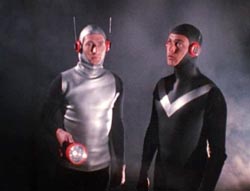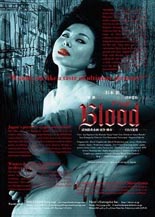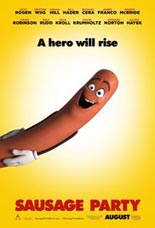
 An open challenge to Seth Rogen: Try to write a feature-length comedy that contains none of your three crutches. To reiterate the obvious, those are:
An open challenge to Seth Rogen: Try to write a feature-length comedy that contains none of your three crutches. To reiterate the obvious, those are:
• the word “fuck” and all its variations/conjugations;
• references to the male member, especially being sucked and/or jerked;
• and pot-smoking.
He cannot do it. That trusty troika of fallbacks comprises his entire arsenal. Movie to movie, each and every one is trotted out incessantly for jokes — not to set up jokes, not to pay off jokes, but to be the jokes. More on that in one hot minute.
Sausage Party represents the worst offender of Rogen and co-scribe Evan Goldberg’s stoned bag of tricks. And because the film is animated, they’ve doubled down on their juvenile instincts in order to appear more subversive than the cartoon would be in sheer concept alone. That concept, in a nutshell (or a jar of Butt Nutter peanut butter, to borrow a Party-going character) is that, unbeknownst to us (unless you’re trippin’ on bath salts), all the food items in your local grocery store are sentient sexual beings.
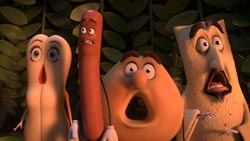 The hot dog Frank (Rogen, Neighbors 2: Sorority Rising) is particularly eager to wrangle free of his vacuum-packed packaging so he can slip inside a bun named Brenda (Kristen Wiig, this year’s Ghostbusters remake). Certainly you’re able to see through the subtlety (because it’s completely transparent) and know that means intercourse. Keeping them from doing that are two primary obstacles:
The hot dog Frank (Rogen, Neighbors 2: Sorority Rising) is particularly eager to wrangle free of his vacuum-packed packaging so he can slip inside a bun named Brenda (Kristen Wiig, this year’s Ghostbusters remake). Certainly you’re able to see through the subtlety (because it’s completely transparent) and know that means intercourse. Keeping them from doing that are two primary obstacles:
• the revelatory admission that being purchased by a customer leads to being eaten
• and a douchebag — literally, a douchebag (Nick Kroll, TV’s The League) seeking revenge for his bent nozzle, which he’s itching to jam into a vagina … but he’ll settle for a dude’s asshole.
Co-directed by Conrad Vernon (Monsters vs. Aliens) and Greg Tiernan (approximately 100 episodes and videos in the Thomas & Friends kiddie franchise!), the movie truly has a lot going for it technically, from ace character design to seamless computer animation. Spirited voice work gets delivered from the likes of Michael Cera, Craig Robinson, Salma Hayek and Edward Norton as, respectively, a malformed wiener, a gangsta box of grits, a lesbian taco and a bagel that may as well be named Woody Allen.
Too bad they’re ill-served by an elementary premise and a junior-high script that assumes the acts of copulation and bong-hitting are hee-larious, in and of themselves and entirely lacking context. It’s like that kid in the back of the class who would say things like “cunt” and “flappy fuck” in a bid for attention. The difference is that his remarks cost nothing; Rogen and company’s, about $30 million. Sausage Party is not clever enough to merit the markup. In fact, it’s rotten. —Rod Lott

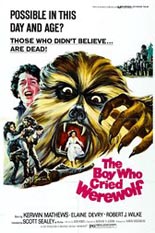
 Here is why parents should never get divorced: Wounds cut deep. Resentment boils and festers. Kids are hurt the most. Dad sprouts fangs.
Here is why parents should never get divorced: Wounds cut deep. Resentment boils and festers. Kids are hurt the most. Dad sprouts fangs. 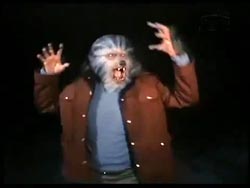
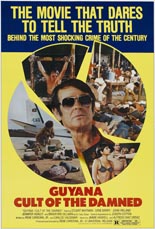
 Stuart Whitman is the Rev. Jim Jones in Guya … wait, what? Okay, if you say so.
Stuart Whitman is the Rev. Jim Jones in Guya … wait, what? Okay, if you say so.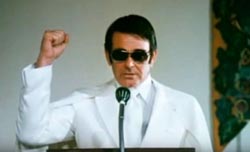
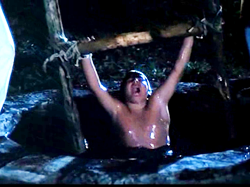
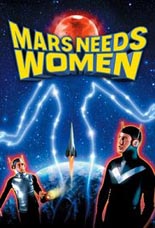
 Popular culture owes Larry Buchanan a mountain of debt, because if not for the Texas-based filmmaker’s
Popular culture owes Larry Buchanan a mountain of debt, because if not for the Texas-based filmmaker’s 